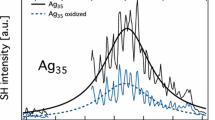n
+ clusters (n=2-9)deposited onto highly oriented pyrolytic graphite (HOPG) substrates at liquid nitrogen temperatures. The deposition was carried out with variable kinetic energies of the clusters. Clusters deposited with high kinetic energy (up to 60 eV/cluster) become fragmented upon impact. For low deposition energies (1–4 eV/cluster) the size dependence of the photoelectron spectra reveals a pronounced odd/even effect, which is well known for gas phase silver clusters. This indicates that the soft deposited clusters retain their size and identity on the sample. The phase of the odd/even effect suggests that transient negatively charged cluster ions serve as an intermediate step in the two-photon photoemission process. The lifetime of the anions rises with cluster size. This is attributed to an increasing electronic density of states for larger clusters.
Similar content being viewed by others
Author information
Authors and Affiliations
Additional information
Received: 26 October 1998 / Revised version: 16 December 1998
Rights and permissions
About this article
Cite this article
Busolt, U., Cottancin, E., Röhr, H. et al. Cluster–surface interaction studied by time-resolved two-photon photoemission . Appl Phys B 68, 453–457 (1999). https://doi.org/10.1007/s003400050648
Issue Date:
DOI: https://doi.org/10.1007/s003400050648




